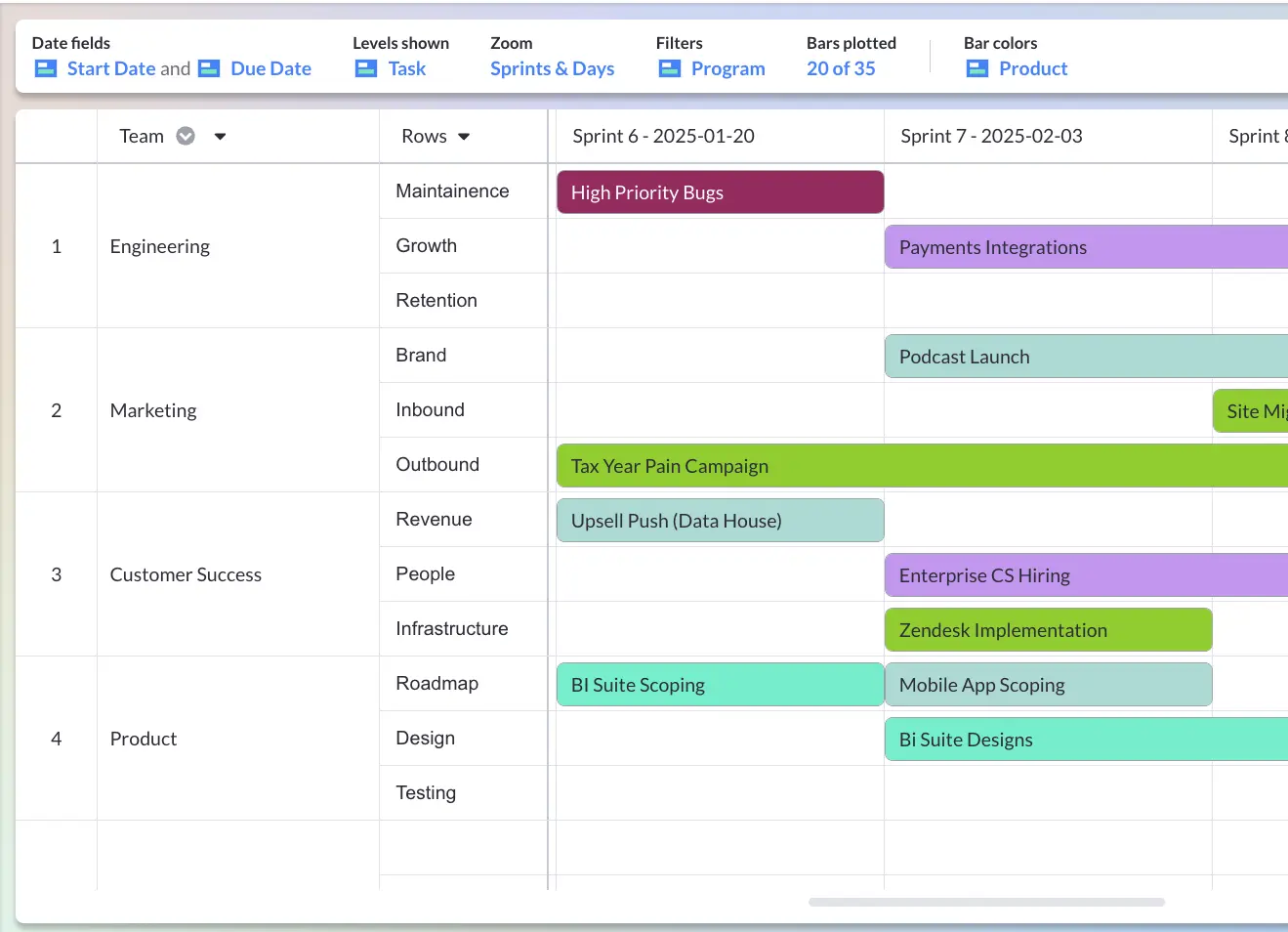
Hybrid Schedule Compression Techniques For Project Managers
Schedule compression techniques are used in project management to reduce the duration of a project without changing its scope. Put simply, this means getting the same amount of work done in a shorter amount of time.
You could be the world’s most effective planner. You could use all the best tools and methodologies. Your team could have crystal clear alignment. Your resources could be top-notch. And in spite of it all you’ll still sometimes get off-track on your projects.
That’s when it’s time for a phrase that evokes mixed emotions in many a seasoned project manager: schedule compression.
Compressing your schedule can ensure that a project meets its deadlines. In theory, it saves scope and quality of your project while allowing you to get it done much faster. But that’s only if you do it right. Schedule compression techniques give you a roadmap to follow to make sure that the work you do is meaningful.
What Are Schedule Compression Techniques?
Schedule compression techniques are used by project managers to reduce a project’s duration without changing its scope.
This means the same amount of work – or at least achieving the same result – in a shorter amount of time. This may seem daunting, or even asking for the impossible, but there are two main techniques that are used to make this process achievable while preventing burnout in your project team.
Schedule compression techniques aren’t meant to be used regularly, or as a typical way of working. They’re utilized only when needed, because they have costs, and risks, which need to be weighed against the benefit of getting projects finished faster.
Schedule compression techniques are used by project managers when:
- Projects are falling behind schedule (not a day or two, significant or sustained delays)
- The previous deadline has been revised and a new, sooner deadline needs to be met
- There is something ahead in the plan that you assess has a high likelihood of delaying the project (in this instance compression techniques are preventative)
- New, and often time-sensitive opportunities or threats have emerged that your project will have a big impact on (and so more can be gained by completing your project sooner)
There are two main schedule compression techniques, these are:
- Fast-Tracking: Taking tasks that were planned to be completed sequentially (think classic waterfall) and instead completing them in parallel (at the same time)
- Crashing: Adding more resource to critical path activities. Literally throwing more weight behind those potential blockers.
Fast tracking and crashing are covered in more detail below.
Should you even be compressing your schedule?
Here’s a controversial statement: sometimes deadlines change, and that’s ok! If the job needs to be done right more than it needs to be done on time, if the deadline was fairly arbitrary to begin with, if you’ve got so many other higher-priority issues on your plate that this one is just falling through the cracks… consider just letting your deadline change. It may bring less stress and woe for you and your team.
Still, you’re likely to encounter situations where the deadline is a must. Perhaps other projects are dependent on it, maybe there’s a cut-off imposed by an external system, maybe you’ve just changed too many deadlines and you’re risking client churn. Whatever the case, if the deadline cannot be moved, that’s when to compress the schedule.
There are two main methodologies to effective schedule compression. Let’s go over both, then talk about why hybridizing might be your secret weapon.
A Timeline In Visor:

Fast-Tracking
So what does it mean to fast-track a project? Fast-tracking is when you complete the most necessary tasks on your critical path all at once, rather than one at a time.
If you’ve determined a critical path – the tasks you need to get done to complete the project in the shortest possible amount of time – you can fast-track. Fast-tracking is all about finding which tasks aren’t dependent on one another and working on them at the same time, so that you can get as much of the crucial work done as possible in the shortest time frame.
That is to say, instead of doing Task A, then Task B, then Task C, you’ll do all three tasks over the same time period.
Fast-tracking a project generally involves a lot of shuffling of timelines. You may need to switch out which team members are working on which tasks, for instance.
If done well, fast-tracking shouldn’t result in a cost change, since it’s mostly about altering team schedules. It’s not without risks, however. Working this way increases the risk of errors, maybe even demanding redoing parts of the project. This would defeat the entire purpose, so you’ll want to make sure that the QA process is thorough and detailed.
Crashing
If that’s fast-tracking, what does it mean to crash a project? When you crash in schedule compression, you’re committing more resources to getting a project done on time.
To make crashing work properly, you need to ensure that you’re pouring your resources into the places they’ll be most effective, rather than just tossing money or time at a project and hoping it works out.
Obviously, this comes with some major downsides. It can be more expensive, sometimes significantly more. When you allocate human resources, such as overtime, you risk burning out your team. Happily, crashing has far less associated risk of the work going wrong, since it’s not trying to do too many things all at once.
Crashing can work especially well when you have resources free to re-allocate in order to ensure a job is done on time. If the deadline is more important than the budget, crashing can be the perfect solution.
Hybridizing
But what if I told you that you may be able to hybridize these methods to see even greater success?
When you approach these methodologies as tools in a tool box rather than hard and fast solo approaches, you can pick and choose what works best for you and your project rather than committing to just one plan.
For instance, you might identify some items in your roadmap that can be completed at the same time, as with typical fast-tracking. But many teams are working on more than one project at once. There’s overlap and only so much bandwidth available to get the job done. You can’t just put more people on the problem, or lay it all on one person, without something giving somewhere.
In this case, you’ll want to take a little extra time to lay the full scope of the project out. Identify not only the critical path, but also the difficulty associated with each item on it. You’ll want to look for:
- What needs to be done
- How long will each task take
- What tasks can be fast-tracked
- What does team bandwidth look like
- What resources are available for allocation
At this point, it becomes a ballet of shifting resources and priorities at the same time. Done will, using both crashing and fast-tracking at once will allow you to reduce both spend and risk.
Maybe you can have your best programmer create multiple elements of a product feature at the same time, but only if they have someone else taking over admin tasks. Maybe someone else can take those admin tasks, but only if they have an hours adjustment to do so. It’s all about finding the right balance.
Hybrid schedule compression is not for every situation. If your case fits cleanly into the above descriptions of fast-tracking and crashing, you probably don’t need to try to hybridize. But if you have a complex project that’s falling behind on multiple fronts, or you just don’t have enough time or resources to commit to one method or the other fully, embracing a hybrid approach to schedule compression might be the solution you’re looking for.
Follow These Schedule Compression Techniques For Success
Nobody wants their schedule to get out of whack. Schedule compression is generally stressful and isn’t much fun to deal with. But hopefully these schedule compression techniques will make the process a little bit easier.
If you’re looking to get a better hold on your schedule from the start, you may need better tools. What about something that can help your whole team find alignment — no matter what tools they’re using? Try Visor. Visor is a project portfolio management tool that syncs with apps like Jira and Asana. Visor also offers many free templates; whether you want to create a simple Gantt chart template or need agile-specific templates like sprint retrospectives, you can explore our library and find the right for for you.
If you want to dig deeper into issues with scheduling and capacity, or any other big problem you’re encountering, you should apply project management troubleshooting methods such as root cause analysis, or the five why’s, to help you get a detailed picture of each problem’s causes and potential solutions.





